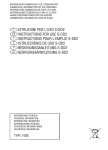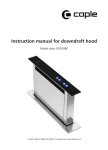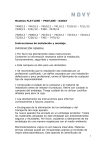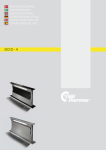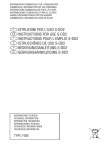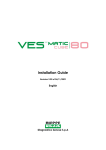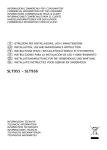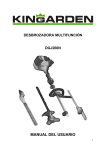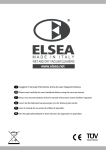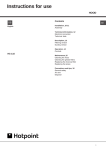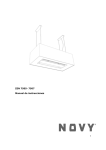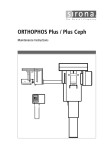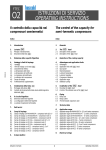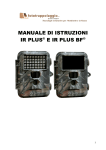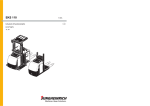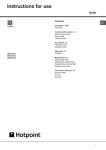Download ISTRUZIONI PER L`USO DOWNDRAFT INSTRUCTIONS FOR USE
Transcript
INFORMAZIONI COMMERCIALI PER I CONSUMATORI COMMERCIAL INFORMATION FOR THE CONSUMER I GB ISTRUZIONI PER L'USO DOWNDRAFT INSTRUCTIONS FOR USE DOWNDRAFT INFORMAZIONI TECNICHE TECHNICAL INFORMATION TYPE: S-DD1 / S-DD2 I Il simbolo sul prodotto o sulla confezione indica che il prodotto non deve essere considerato come un normale rifiuto domestico, ma deve essere portato nel punto di raccolta appropriato per il riciclaggio di apparecchiature elettriche ed elettroniche. Provvedendo a smaltire questo prodotto in modo appropriato, si contribuisce a evitare potenziali conseguenze negative per l’ambiente e per la salute, che potrebbero derivare da uno smaltimento inadeguato del prodotto. Per informazioni più dettagliate sul riciclaggio di questo prodotto, contattare l’ufficio comunale, il servizio locale di smaltimento rifiuti o il negozio in cui è stato acquistato il prodotto. Questo elettrodomestico è marcato conformemente alla Direttiva Europea 2002/96/CE sui rifiuti da apparecchiature elettriche ed elettroniche (WEEE). GB The symbol on the product or on its packaging indicates that this product may not be treated as household waste. Instead it shall be handed over to the applicable collection point for the recycling of electrical and electronic equipment. By ensuring this product is disposed of correctly, you will help prevent potential negative consequences for the environment and human health, which could otherwise be caused by inappropriate waste handling of this product. For more detailed information about recycling of this product, please contact your local city office, your household waste disposal service or the shop where you purchased the product. This appliance is marked according to the European directive 2002/96/EC on waste electrical and electronic equipment (WEEE). D Das Symbol auf dem Produkt oder seiner Verpackung weist darauf hin, dass dieses Produkt nicht als normaler Haushaltsabfall zu behandeln ist, sondern an einem Sammelpunkt für das Recycling von elektrischen und elektronischen Geräten abgegeben werden muss. Durch Ihren Beitrag zum korrekten Entsorgen dieses Produkts schützen Sie die Umwelt und die Gesundheit Ihrer Mitmenschen. Umwelt und Gesundheit werden durch falsches Entsorgen gefährdet. Weitere Informationen über das Recycling dieses Produkts erhalten Sie von Ihrem Rathaus, Ihrer Müllabfuhr oder dem Geschäft, in dem Sie das Produkt gekauft haben. Dieses Elektrohaushaltsgerät ist entsprechend der EU-Richtlinie 2002/96/CE Über Elektro- und Elektronik – Altgeräte (WEEE). 2 I INDICE Presentazione Avvertenze Versioni d’uso Installazione Funzionamento Manutenzione 3 PRESENTAZIONE Elegante e funzionale, ecco come si presenta il nuovo prodotto per aspirazione realizzato dalla Sirius spa. Un sistema di aspirazione a scomparsa, abbinabile ad ogni design di cucina, elegante e discreto sia per applicazioni ad isola che a muro. Una soluzione perfetta, per applicazione in spazi limitati con una capacità di aspirazione superiore, grazie al sistema perimetrale e ai filtri in alluminio posizionati dietro l’elegante pannello frontale in acciaio con una rumorosità impercettibile grazie al nuovo sistema di scorrimento. AVVERTENZE ATTENZIONE: non posizionare pentole e non orientare manici di pentole nella parte superiore del downdraft per evitare eventuali capovolgimenti. adulti. I bambini, le persone inesperte o i disabili possono utilizzare l’apparecchio solo sotto la supervisione di L’aria raccolta non deve essere convogliata in un condotto usato per lo scarico di fumi di apparecchi alimentati con energia diversa da quella elettrica (impianti di riscaldamento centralizzati, termosifoni, scaldabagni, ecc.). Per lo scarico dell’aria da evacuare rispettare le prescrizioni delle autorità competenti. Prevedere una buona areazione del locale in cui viene utilizzato il prodotto aspirante e altri apparecchi alimentati con energia diversa da quella elettrica (stufe a gas, impianti a legna, carbone, olio ecc). Evitare l’uso di materiali che causano fiammate (flambè) nelle immediate vicinanze dell’apparecchio. Nel caso di fritture fare particolarmente attenzione al pericolo di incendio che costituiscono olio e grassi. Particolarmente pericoloso per la sua infiammabilità è l’olio già usato. Non usare griglie elettriche scoperte. Per evitare un possibile rischio di incendio attenersi alle istruzioni indicate per la pulizia dei filtri antigrasso. Non utilizzare il prodotto senza filtri antigrasso; Non è autorizzato l’uso del prodotto per scopi diversi da quelli per cui è stato progettato; Per il normale funzionamento del downdraft è necessario utilizzare un gruppo aspirante (motore esterno) della stessa casa produttrice, nel caso di versione esternal motor. Per conseguenze o danni derivati da un errata installazione e utilizzo dell’apparecchio la ditta fornitrice non risponderà di alcuna garanzia. Prima di procedere a qualsiasi tipo di operazione di pulizia o manutenzione assicurarsi che l’apparecchio sia scollegato dalla rete elettrica. CONSIGLI UTILI - Prima di procedere con l’installazione verificare che tutti i componenti non siano danneggiati, in caso contrario contattare il rivenditore e non proseguire con l’installazione. - Prima di installare il prodotto leggere attentamente tutte le istruzioni di seguito riportate; - Utilizzare un tubo evacuazione aria che abbia la lunghezza minima possibile; - Limitato numero di curve; - Materiale approvato normativamente; - Evitare cambiamenti drastici di sezione (diametro costante consigliato: Ø 150mm o pari superfice); La pressione negativa (depressione) della stanza in cui è attivo il prodotto aspirante non deve superare 4Pa (0,04mbar), questo è garantito da ingressi d’aria come porte, finestre, bocchette d’areazione ecc. Per il mancato rispetto delle precedenti istruzioni la ditta fornitrice non risponderà per problemi di portata o di rumorosità e nessuna garanzia sarà prestata. Quando l’etichetta dati tecnici attaccata al prodotto non mostra il simbolo l’apparecchio è in classe I quindi necessità di collegamento a terra. DESCRIZIONE Prima di collegare il prodotto aspirante alla rete elettrica verificare che i valori di tensione corrispondano con i dati riportati dalla targhetta tecnica attaccata al prodotto. Se l’apparecchio non è provvisto di spina o se al termine dell’installazione questa non è facilmente accessibile è necessario prevedere un dispositivo di separazione del prodotto aspirante dalla rete elettrica che abbia una distanza di apertura dei contatti di tutti i poli di almeno 3mm. Il Downdraft è stato realizzato per essere alloggiato all’interno del mobile in posizione orizzontale nella zona posteriore al piano cottura, sia con motore a bordo che in versione external motor. Il modello SDD1 è disponibile solo in versione esternal motor. Dopo aver estratto l’unità aspirante, l’aspirazione dei vapori e dei fumi, avviene attraverso il canale posto nella parte superiore del pannello mobile. Il mod. SDD2 prevede anche la versione filtrante, mediante l’utilizzo dei filtri carbone 4 (Dis. 15C ), con riciclo all’interno della cucina. 2) Effettuare nella parte posteriore del piano della cucina, un foro rettangolare delle dimensioni di 790x100 mm o 535x100 mm rispettivamente per le dimensioni da 90Cm e da 60Cm. (Vedi dis. 13) 3) Nel caso si desideri posizionare il Downdraft attaccato al piano cottura è possibile unire il foro del Downdraft con quello del piano cottura. 4) Prima di effettuare il foro controllare che nella parte interna del mobile, in corrispondenza della zona di alloggio del downdraft, non sia presente la struttura del mobile o altri particolari che potrebbero creare problemi per la corretta installazione. Verificare che gli ingombri del downdraft e del piano cottura siano compatibili con il mobile e quindi sia fattibile l’installazione. 5) Installare il downdraft nel foro praticato, inserendolo da sopra, come indicato dal Dis. 3; 6) La cornice in acciaio del downdraft deve aderire perfettamente al top della cucina; 7) Fissare il downdraft all’interno del mobile utilizzando le apposite staffe (Dis. 11 A). In base alle dimensioni del mobile e agli ingombri del condotto uscita aria utilizzare le staffe di fissaggio in dotazione. Attenzione: non praticare ulteriori fori sul prodotto, per evitare di danneggiare i componenti interni di scorrimento ed elettrici. 8) Nel caso della versione con motore a bordo procedere al montaggio del gruppo motore orientando l’uscita dell’aria nella posizione prescelta verso il basso o verso l’alto. (Dis.11). Ad avvenuta installazione del motore procedere al montaggio della canalizzazione per l’uscita dell’aria. 9) Nel caso di versione con motore esterno posizionare in una zona idonea l’eventuale gruppo aspirante (motore esterno) e disporre il condotto di evacuazione dell’aria di scarico come da Dis.10. Procedere al montaggio della canalizzazione uscita aria tra il motore esterno e il downdraft; Selezionare l’uscita aria tra le cinque possibilità (Dis.12) ed installare il raccordo in dotazione. Il gruppo aspirante (motore esterno) deve essere della stessa casa produttrice del Downdraft. 10)Posizionare la scatola metallica contenente i componenti elettronici in una zona facilmente accessibile per eventuali interventi di assistenza (Dis.14), collegando i connettori elettrici della stessa al downdraft (Dis.14). 11)Nel caso di motore esterno collegare il cavo del gruppo motore all’apposito connettore sulla scatola dei componenti elettronici. 12)Collegare il prodotto alla rete elettrica. INSTALLAZIONE ATTENZIONE: Il Downdraft S-DD1 non può essere installato su piani cottura a GAS. SDD1 ASSICURARSI CHE IL DOWNDRAFT NON SIA ACCESO E SIA SCOLLEGATO IL CAVO ALIMENTAZIONE SDD1 1) Per il normale funzionamento occorre eseguire un corretto montaggio del downdraft e posizionare in una zona idonea il gruppo aspirante (motore esterno), mediante il collegamento di condotto di evacuazione dell’aria di scarico come da dis. 1; 2) Nella parte posteriore del piano di lavoro, partendo dal foro precedentemente ricavato per il piano cottura, effetture un ulteriore foro rettangolare delle dimensioni pari a 785x70mm nel caso di downdraft con larghezza 880 mm e 530x70mm nel caso di downdraft con larghezza 580mm (Vedi dis. 2). Prima di effettuare il foro controllare che nella parte interna del mobile, in corrispondenza della zona di alloggio del downdraft, non sia presente la struttura del mobile o altri particolari che potrebbero creare problemi per la corretta installazione. Verificare che gli ingombri del downdraft e del piano cottura siano compatibili con il mobile e quindi sia fattibile l’installazione. 3) Installare il downdraft nel foro praticato, inserendolo da sopra, come indicato dal Dis. 3; 4) Il bordo superiore del downdraft deve arrivare a contatto con il top della cucina (Dis.4); 5) Fissare il downdraft all’interno del mobile utilizzando le staffe di fissaggio come dimostra il Dis. 5; 6) E’ possibile regolare la direzione d’uscita aria verso destra, sinistra o verso il basso in base alle esigenze, rimuovendo le 8 viti di fissaggio e ruotando il raccordo metallico. Ripristinare le viti come dimostra il dis. 6. 7) Installare il gruppo aspirante (motore esterno) seguendo le relative instruzioni. 8) Effettuare il collegamento dei tubi per convogliare l’aria, la flangia uscita aria del downdraft corrisponde alle dimensioni di 230x80mm; 9) Collegare il downdraft al gruppo aspirante (motore esterno) mediante il cavo elettrico in dotazione, già fissato al gruppo aspirante (motore esterno), effettuare il collegamento del downdraft alla rete elettrica. 10)Estrarre il pannello aspirante pigiando il tasto ON/1 (B), successivamente rimuovere il pannello frontale (Dis. 9A), premendo gli angoli in alto verso l’interno, quindi reperire dall’imballo i filtri antigrasso (Dis.9B) e posizionarli nell’apposita sede come dimostra il dis.9. Ripristinare il pannello frontale. 11)Il gruppo aspirante (motore esterno) deve essere della stessa casa produttrice del Downdraft. Calibrazione del Downdraft SDD1 / SDD2 Dopo aver installato il Downdraft, occorre avviare la procedura di autocalibrazione necessaria a regolare lo sforzo di estrazione dell’unità filtrante. Collegare il prodotto alla rete elettrica facendo attenzione che sia conforme alla tensione di alimentazione richiesta dalla targhetta dati tecnici. Premere il tasto ON/1 (dis. 7B SDD1-SDD2, dis. 8H SDD2 T.C.), inizia l’estrazione dell’unità filtrante, raggiunti i 18Cm di altezza dell’unità filtrante, premere nuovamente il tasto ON/1 (SDD1/SDD2) - OFF (SDD2 touch control) per arrestare la salita; successivamente premere il tasto TIMER (dis. 7F / dis. 16M) ed entro due secondi il tasto OFF. SDD2 1) Per un buon funzionamento del downdraft occorre eseguire una corretta installazione. 5 A questo punto il Downdraft esegue la calibrazione dell’unità filtrante spostandola in alto e in basso per alcuni centimetri, durante questa fase i tastini della pulsantiera comandi lampeggiano. Terminata l’autocalibrazione l’unità filtrante torna nella posizione precedente e i tastini smettono di lampeggiare. Attendere l’arresto dell’unità filtrante e successivamente riprendere in normale utilizzo del Downdraft. FUNZIONAMENTO Mod. Downdraft - vers. Standard (Dis.7) SDD1/SDD2 A: Interruttore discesa pannello aspirante / OFF Ha la funzione di chiusura del pannello aspirante sia in forma totale che su posizioni intermedie al di sopra di 180 mm dal piano di cottura. Durante la chiusura il pannello aspirante rimane in funzione alla velocità impostata fino all’altezza di 180mm dal piano di cottura. Al di sotto di tale dimensione la funzione di aspirazione si interrompe automaticamente. B: Interruttore salita pannello aspirante ON/ I° velocità Ha la funzione di estrazione del pannello aspirante fino all’altezza massima di 300mm e di impostazione automatica della prima velocità di aspirazione al raggiungimento dell’altezza di 180mm dal piano di cottura. Premendo ulteriormente il tasto dopo il raggiungimento di tale dimenzione è possibile posizionare il pannello aspirante su posizioni intermedie desiderate fino all’altezza massima di 300mm mantenendo invariata la velocità di aspirazione. C: Interruttore II° velocità D: Interruttore III° velocità E: Interruttore IV° velocità Hanno la funzione di impostare le rispettive velocità di aspirazione dopo che il pannello aspirante ha raggiunto l’altezza di 180mm dal piano di cottura e di posizionare in posizioni differenti l’altezza del pannello aspirante ripremendo lo stesso tasto fino al massimo di 300m. F: Temporizzatore 10 min Ha la funzione di arresto automatico del sistema di aspirazione e di chiusura automatica del pannello aspirante dopo dieci minuti dalla sua impostazione. Mod. Downdraft SDD 2 - vers. Touch Control (Dis. 16) Tasto OFF (dis. 16G) Ha la funzione di chiusura del pannello aspirante sia in forma totale che su posizioni intermedie al di sopra di 180 mm dal piano di cottura, durante la chiusura il pannello aspirante rimane in funzione alla velocità impostata fino all’altezza di 180mm dal piano di cottura. Al di sotto di tale dimensione la funzione di aspirazione si interrompe automaticamente. Nel caso in cui il pannello aspirante sia posizionato ad un altezza intermedia compresa tra 180 mm e 300mm è possibile riavviare la salita del pannello aspirante agendo prima sul tasto OFF e successivamente sul tasto On/+. Leds (Dis. 16I) Le velocità di funzionamento vengono indicate dai leds blue (1° velocità led in basso a sinistra). TASTO MENO: (Dis. 16 L) è attivo solo se l’altezza del pannello aspirante è superiore ai 18cm dal piano cottura e consente di ridurre la velocità del motore di aspirazione. TASTO TIMER (dis. 10M) : Ha la funzione di arresto automatico del sistema di aspirazione e di chiusura automatica del pannello aspirante dopo dieci minuti dalla sua impostazione. Altre funzioni: - Dopo 30 ore di funzionamento dell’apparecchio la pulsantiera evidenzia la saturazione dei filtri antigrasso mediante il lampeggio dei led, per il reset premere il tasto timer. - Dopo 4 ore di funzionamento continuo dall’ultima impostazione l’apparecchio si spegne e si chiude automaticamente. - Durante la rimozione del pannello anteriore per operazioni di pulizia e manutenzione tutte le funzioni elettroniche di aspirazione e movimento sono bloccate. MANUTENZIONE Un’accurata manutenzione garantisce un buon funzionamento ed un buon rendimento nel tempo. Una cura particolare va rivolta al filtro antigrasso. La rimozione del filtro antigrasso avviene in primo luogo estraendo il carrello aspirante pigiando il tasto ON/1 (Dis. 7B / dis. 8H), successivamente rimuovere il pannello frontale (Dis. 9A), premendo i spigoli in alto verso l’interno, quindi estarre i filtri antigrasso (Dis.9B). La pulizia dei filtri antigrasso può essere eseguita a mano o in lavastoviglie. I filtri antigrasso devono essere puliti regolarmente poiché possono costituire pericolo d’incendio. Ripristinare i filtri antigrasso e il pannello frontale facendo attenzione che sia ben agganciato in entrambi i lati altrimenti potrebbe causare l’inceppamento del carrello filtrante. Nel caso di SDD2 nella versione filtrante è necessario sostituire i filtri carbone attivo (Dis. 15 C) periodicamente. IL filtro carbone si rimuove togliendo prima il filtro antigrasso e successivamente il filtro carbone (Dis. 15 C). La sostituzione del filtro carbone avviene in rapporto all’uso, almeno una volta ogni 6 mesi. Tasto On/+ (Dis.16H) Ha la funzione di estrazione del Per la pulizia dell’apparecchio viene consigliato l’uso di pannello aspirante fino all’altezza massima di 300mm panno morbido acqua tiepida e detersivo neutro, evitando e di impostazione automatica della prima velocità di l’uso di prodotti contenenti abrasivi o corrosivi. aspirazione al raggiungimento dell’altezza di 180mm dal piano di cottura. La sostituzione del cavo alimentazione deve essere Premendo ulteriormente il tasto dopo il raggiungimento effettuata solo da personale specializzato. di tale dimensione è possibile aumentare la velocità del motore di aspirazione. 6 GB CONTENTS Presentation Warnings Uses Installation Working Maintenance 7 For normal operation of Downdraft an extraction unit (external motor) of the same manufacturer is required. PRESENTATION The manufacturer is not responsible for any consequences or damage deriving from improper installation and use of the appliance. Elegant and functional, here is how the new ventilation product designed by Sirius SpA looks. A “hideaway” exhausting system that fits every kitchen design, elegant and unobtrusive on both island and wall applications. It is the perfect solution for limited space application with a superior exahusting efficiency, thanks to its perimetral suction system and to the aluminium filters positioned behind the elegant stainless steel front panel, and with an extremely low noise level thanks to a new sliding system. Before proceeding with any type of cleaning or maintenance operation, check that the appliance is disconnected from the mains. USEFUL TIPS - Before proceeding with installation, check that none of the components are damaged. If otherwise, contact the dealer and do not continue with installation. - Before installing the appliance, carefully read all the instructions. - Use an air duct of minimum indispensable length. - Use a limited number of elbows. - Use certified materials. - Avoid drastic changes in cross-section (recommended constant diameter: 150 mm Ø or equal cross-sectional area). WARNINGS ATTENTION: do not put pots and do not set handles of saucepans on the upper side of the downdraft in order to avoid that they turn upside down. The appliance may be used by children, inexpert or disabled persons only under supervision of adults. The drawn air must not be conveyed into a duct used for extraction of flue gas of equipment powered with energy different from electrical energy (central heating systems, thermosiphons, water heaters, etc.). For air evacuation comply with the regulations laid down by the competent authorities. Provide for good ventilation in the room housing the extraction system and other equipment powered with energy different from electrical energy (gas stoves, wood-, carbon- and oil-powered systems, etc). The negative pressure (vacuum) of the room in which the extraction system is active must not exceed 4Pa (0.04 mbar). This is assured by means of air inlets such as doors, windows, vents, etc. The manufacturer cannot be held responsible for air flow or noise problems if failing to comply with the above instructions and no guarantee is provided. DESCRIPTION The Downdraft has been designed to be housed in a cabinet, horizontally on the back side of the cooktop, both in the appliance equipped with motor and in the external motor version appliance. The model SDD1 is available only in external motor version. After extracting the exhausting unit, the aspiration of vapours and fumes occurs by means of a opening placed on the upper side of the vertically-sliding panel. The model SDD2 is available in filtering version as well, by using carbon filters (Fig. 15C ) so to recycle air inside the kitchen. When the label on the product bearing the technical data does not show the symbol the appliance is classified in Class I and hence requires an earth connection. Before connecting the extraction system to the mains, check that the voltage values correspond to the data shown on the plate fixed on the product. If the appliance is not fitted with a plug or if it is not easily accessible after installation, fit a device to isolate the extraction system from the mains with a contact opening distance of at least 3 mm for all the poles. Do not use ingredients that cause flames (flambè) in the immediate vicinity of the appliance. In the case of frying, be particularly careful since oils and grease constitute a fire hazard. In particular, used oil has a high risk of inflammability. Do not use uncovered electric grilles. To prevent the risk of fire, follow the grease filter cleaning instructions. Do not use the aspiration panel without grease filters. The aspiration panel may not be used for purposes different from those for which it was designed. INSTALLATION ATTENTION: The Downdraft S-DD1 cannot be installed on gas hob. SDD1 1. For normal operation Downdraft must be properly installed and the extraction unit (external motor) 8 positioned in a suitable area by connecting the air duct as shown in Fig. 1. 2. At the rear of the worktop, starting from the opening previously made for the cooktop, extend the opening by 785x70 mm for a 860 mm wide Downdraft and 530x70 mm in the case of a 580 mm wide Downdraft (see Fig. 2). Before making the opening, check that there are no structural or other parts inside the cabinet that hinder proper installation of Downdraft. Check that the dimensions of Downdraft and the cooktop are compatible with the cabinet so that the installation can be carried out properly. 3. Fit Downdraft in the opening, inserting it from the top as shown in Fig. 3. 4. The upper edge of Downdraft must be in contact with the worktop (Fig. 4). 5. Fix Downdraft inside the cabinet using the fixing brackets as shown in Fig. 5. 6. The air evacuation direction can be adjusted to the right, left or down as required, by removing the 8 retaining screws and turning the metal union. Refit the screws as shown in Fig 6. 7. Install the extraction unit (external motor) following the relevant instructions. 8. Connect the air ducts; the dimension of the air outlet flange of Downdraft is 230x80 mm. 9. Connect Downdraft to the extraction unit (external motor) using the cable provided already fitted to the extraction unit (external motor) and connect Downdraft to the mains. 10. Extract the aspiration panel by pressing the button ON/1 (B), then remove the front panel (Fig. 9A), pressing the upper corners inside. Take the grease filters (Fig. 9B) out of the packaging and position them in their housing as shown in Fig. 9. Refit the front panel. 11.The extraction unit (external motor) must be from the same manufacturer as Downdraft. Attention: do not make any additional openings on the appliance in order to avoid to damage the internal sliding and electrical components. 8. In the version of the Downdraft equipped with motor, install the motor group adjusting the air evacuation direction as required, either downwards or upwards (Fig. 11). After installing the motor, connect the air ducts. 9. In the external motor version, put the extraction unit (external motor) in a proper place and connect the air evacuation duct as shown in Fig. 10. Afterwards connect the air outlet duct between the external motor and the Downdraft. Select the air outlet among the five possibilities shown (Fig. 12) and install the joint provided. The extraction unit (external motor) must be from the same manufacturer as the Downdraft. 10.Put the metallic box containing the electronic components in a place easy to be reached if a technical assistance is needed Fig. 14). Connect the electrical connectors of the box to the Downdraft . 11.If the motor is external, connect the motor unit cable to the suitable connector placed on the electronic components box. 12.Power the appliance. Downdraft calibration (SDD1-SDD2) After the downdraft has been installed, the aspiration panel must be calibrated. This operation is necessary to regulate the power exstraction of the aspiration panel. Connect the product to the power line, making sure that it is conformed to the supply voltage indicated on the technical data tag. Pushing the ON/1 button (fig.7-B) the aspiration panel rises. After it has reached a height of 180mm from the cooketop, press the OFF botton (fig. 7/4), then the Timer (fig. 7-F) and after 2 sec. the OFF button ( Fig. 7-A). The downdraft will carry out the calibration of its aspiration panel rising and retracting for some centimeters. During this phase, the buttons on the pushbutton control panel blink. At the end of the calibration, the aspiration panel get back to the previous position and the button end to blink. Wait until the aspiration panel stops moving before re-activating the extraction. SDD2 1. For a good performance the Downdraft must be properly installed. 2. At the rear of the cooktop make a rectangular opening of mm 90x100 or mm 535x100, respectively for a mm 860 wide Downdraft or for a mm 580 wide Downdraft (Fig. 13) 3. If you would like to place the Downdraft very close to cooktop, connect the opening of the Downdraft to the one of the cooktop. 4. Before making the opening, check that there are no structural or other parts inside the cabinet, where the appliance is to be placed, which could hinder a proper installation. Check that the dimensions of the Downdraft and the ones of the cooktop are compatible with the cabinet so that the installation can be carried out properly. 5. Put the Downdraft in the opening, inserting it from above as shown in Fig. 3 6. The upper edge of the Downdraft must fit perfectly the cooktop. 7. Fix the Downdraft inside the cabinet. According to the dimensions of the cabinet and of the air outlet duct, use the provided fixing brackets (Fig. 11 A). OPERATION Mod. Downdraft SDD 2 - Touch Control version (Fig. 16) A: Aspiration panel down / OFF switch It is used to close the aspiration panel completely or to position it at intermediate heights at least 180 mm above the cooktop. During closure the aspiration panel remains active at the speed set up to the height of 180 mm from the cooktop. Below this height the aspiration function is automatically cut out. B: Aspiration panel up/1st speed switch It is used to extract the aspiration panel up to a maximum height of 300 mm and automatically set the first aspiration 9 speed when reaching the height of 180 mm from the cooktop. When pressing the button again after reaching this height, the aspiration panel can be positioned in intermediate positions up to a maximum height of 300 mm while maintaining the aspiration speed unchanged. MAINTENANCE Careful maintenance guarantees good functioning and goog efficiency over time. C: 2nd speed switch D: 3rd speed switch E: 4th speed switch Particular care should be taken with the grease filter. The grease filter is removed by extracting the aspiration by extracting the aspiration panel by pressing the button ON/1 (Fig. 9-B / Fig.16H). Afterwards remove the front panel (Fig. 9 A SDD1 – Fig. 15 A SDD2) by pushing the upper corners inside, then remove the grease filters (Fig. 9B SDD1 – Fig. 15B SDD2 The grease filters can be hand washed or in the dishwasher. The grease filters must be cleaned regularly as they may constitute a risk of fire. Reinsert the grease filters and the front panel. Make sure that the front panel is properly fixed otherwise it may jam the filtering panel. In the SDD2, in filtering version, the active carbon filters must be replaced regularly (Fig. 15 C). To remove the carbon filter, first remove the grease filter and then the carbon filter (Fig. 15 C). The carbon filter needs replacing depending on the use, but however every six months at least. They are used to set the respective aspiration speeds after the aspiration panel has reached a height of 180 mm from the cooktop and to position the aspiration panel at different heights up to a maximum of 300 mm by pressing the same button again. F: 10-minute timer Its function is to automatically stop the extraction system and close the aspiration panel 10 minutes after it has been set. OFF switch: (Fig. 16G) It is used to close the aspiration panel completely or to position it at intermediate heights at least mm 180 above the cooktop. While closing the aspiration panel keeps on working at the speed set up to the height of mm 180 from the cooktop. Below this height the aspiration function is automatically cut out. On switch/+: (Fig. 16H) It is used to extract the aspiration panel up to the maximum height of mm. 300 and to set automatically the first aspiration speed when reaching the height of mm 180 from the cooktop. When pressing the button again after reaching this height, the aspiration motor speed can be encreased. If the aspiration panel is positioned at an intermediate height between mm 180 and mm 300, the aspiration panel can start raising again by pressing first the OFF switch and then the On/+. Switch. To clean the appliance itself a soft cloth, tepid water and neutral detergent are recommended, while abrasive or corrosive products must be avoided. The power cable must be replaced by specialised personnel only. Leds: (Fig. 16I) The different speed levels are indicated by blue leds. (1. Speed level corresponds to the led down on the left). MINUS SWITCH: (Dis. 16 L) it is working only if the position reached by the aspiration panel is higher than mm 180 from the cooktop. It is used to decrease the aspiration motor speed. TIMER SWITCH: (Fig. 10M) : it is used to stop automatically the aspiration system and to close automatically the aspiration panel ten minutes it has been set. Other functions: · After 30 hours of appliance operation, the pushbutton panel indicates saturation of the grease filters by the buttons flashing. To reset, press the timer button. · After 4 hours of continuous operation from the last setting, the appliance turns off and closes automatically. · When the front panel is removed for cleaning and maintenance operations, all the electronic aspiration and movement functions are locked. 10 11 12












